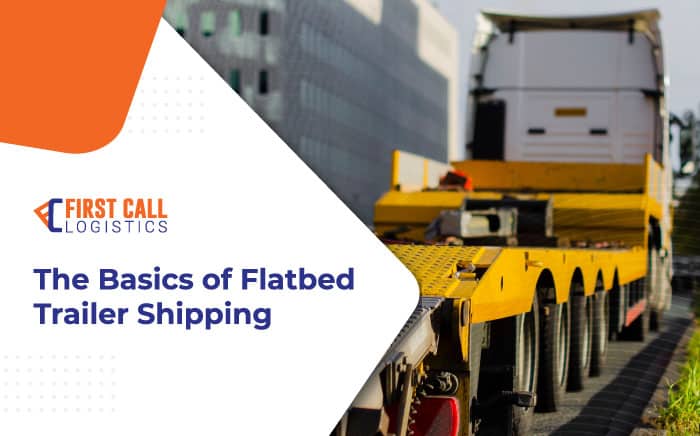The Basics of Flatbed Trailer Shipping

Just like in the movie Jaws, sometimes you need a bigger boat. Or in this case, a bigger truck.
When you need to ship a load that’s taller, wider, or heavier than your dry van capacity can handle, a flatbed trailer is a great option for moving your bulky freight. These flattened hauling platforms give you a way to easily load and unload anything from heavy machinery and vehicles to raw materials and industrial equipment.
Whether you are concerned about the size of your freight or anticipate difficulty in loading and unloading your shipment, here are three things to know about flatbed trailer shipping when planning your logistics.
Flatbed Trailer Limitations
Flatbed trailers come with almost limitless possibilities when it comes to what you may want to ship. Because the majority of flatbed shipping involves materials too large or heavy to go in a dry van, you can treat your flatbed almost like a blank canvas. The most common freight shipping uses of flatbed trucks include:
- Heavy machinery and equipment used by industrial, agricultural, construction, warehousing, and manufacturing companies
- Miscellaneous building materials, including formed concrete items, lumber, construction materials, large beams, or trusses
- Electrical transformers
- Commercial units including heaters and air conditioners
- Scrap metal and other items for removal or disposal
- Freight exceeding 102″ in height or 102″ in width as well as cars and other vehicles.
- Other heavy freight that requires loading from the top or side of the vehicle
So when should you not use a flatbed trailer for shipping your oversize freight? If your cargo is fragile or your materials are light, loosely packed, and at risk of shifting during transit, you may want to consider other options.
How Does a Flatbed Trailer Work?
Because flatbed shipments typically deal with oversized items, you will need some help loading. Plan on using a crane for lifting your materials to load from the top or side of the trailer. If you are using a flatbed trailer as a shipping option for large quantities of wrapped and stackable products, be sure you have the right safety and item security measures in place to ensure your load does not shift or fall in transit. This can be done using straps or chains including ratchets, V-straps, basket straps, or nylon straps to fasten the cargo down and further decrease the chances of dropping your freight.
Another good use for flatbed trailers is when you are shipping and know that your destination does not have adequate docking to unload your freight. This is where your third-party logistics partner’s expertise will add value to your company by giving you access to their network of carriers with the right equipment needed to unload easily from your flatbed trailer.
Flatbed Shapes, Sizes, and Types
You’ll have no shortage of options available to get the job done once you decide that flatbed shipping is the way to go. You’ll want to work closely with your logistics partner to determine what size trailer best fits your needs.
Because flatbed shipping requires time, investment, and coordination, make sure you know the length, width, height, and weight of your shipment. As a general rule, as long as your cargo does not dramatically exceed your trailer’s footprint, the only limit to your shipping potential is your imagination. The most common flatbed trailer is the standard flatbed, which is between 48 and 53 feet long with a bed that sits 42 to 60 inches high that has a capacity of 45,000 to 48,000 pounds. The main deck of the trailer can legally accommodate a load that is 48’ L x 102” W x 8’6” H.
Other types of flatbed options include:
- Double Drop – This trailer has a well or single hauling section that sits 18” off the ground and is usually used for moving taller freight like construction machinery, vehicles, or large aircraft parts.
- Removable Gooseneck – This is a specialty trailer that comes with a removable neck that converts the front of the trailer into a ramp, making it ideal for loading and moving automobiles, mobile homes, and other wheeled equipment like farming or construction vehicles.
- Step Deck – This trailer is used for very tall shipments where extra permits would be needed with another trailer type. A step deck flatbed gives shippers the ability to load products to be shipped 10’ tall without extra permits. It has dual hauling platforms that stand at different heights, with the main bed being the longest and lowest of the two, giving it a step-like appearance and feel.
No matter what type of shipment you are hoping to move, knowing the basics of what you need is half the battle. Once you learn and understand the basics of flatbed shipping (among the other types) you can make decisions about partnering with a logistics company that knows how to scale your operations and extend your reach.
Are you interested in learning more about flatbed shipping services for your business? Reach out to First Call Logistics today!
Simplify your Next Shipment with First Call Logistics
Building and managing cost-efficient supply chains is a full-time job. First Call’s rare combination of in-house assets, expert problem-solving and track record of stellar customer service makes us the 3PL of choice for business partners with a wide range of shipping needs.